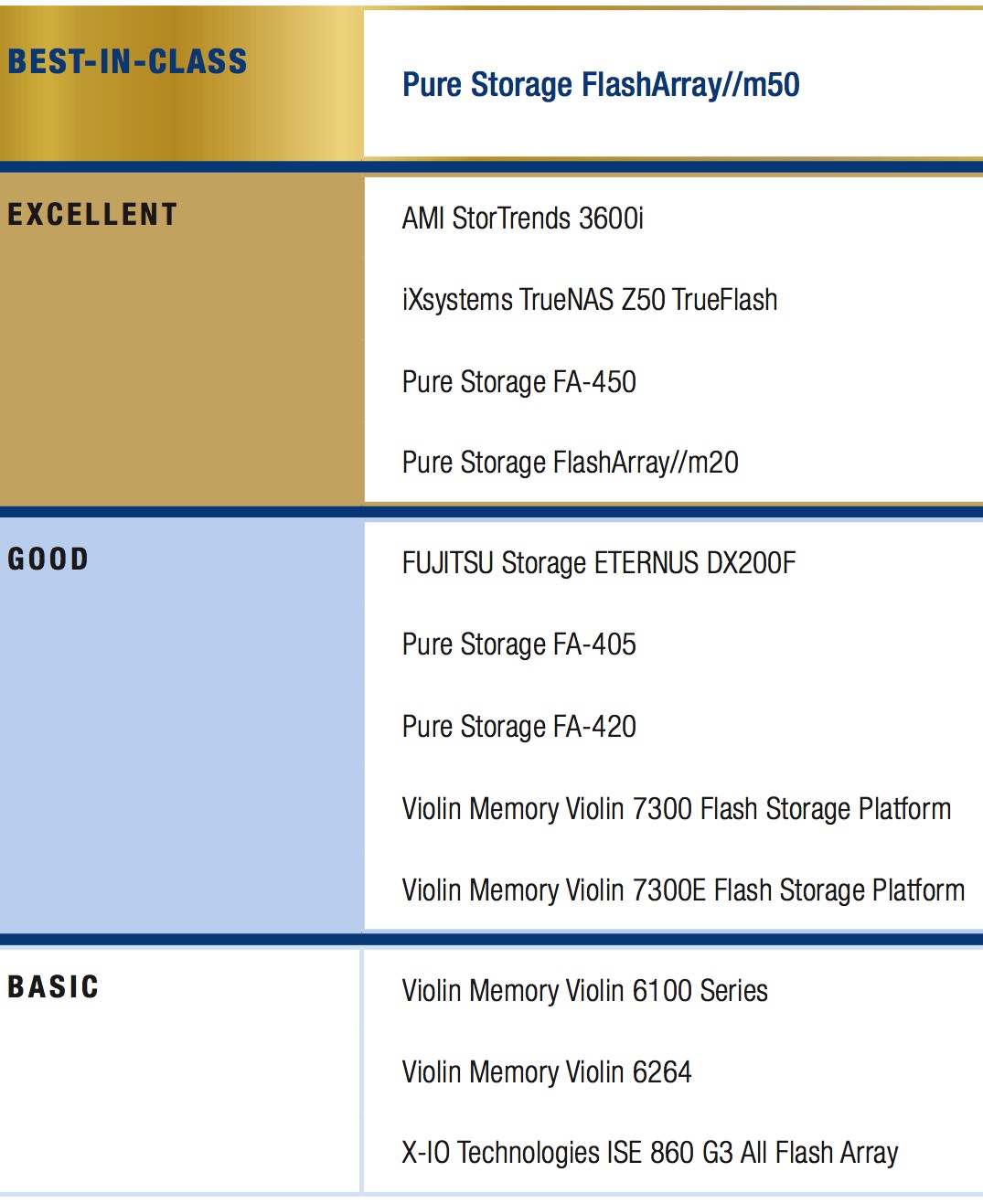Pure Storage FlashArray//m50 Alone as Best-in-Class – DCIG
In sub-100TB all-flash array buyer's guide
This is a Press Release edited by StorageNewsletter.com on December 21, 2015 at 3:05 pmDCIG 2015-2016 Sub-100TB All-Flash Array Buyer’s Guide
By Chuck Cook, analyst, and Ken Clipperton, managing analyst, DCIG, LLC
Introduction
DCIG presents this fresh snapshot of the dynamic all-flash array (AFA) marketplace.
This marketplace is dynamic both in terms of product evolution and in the rate of AFA adoption. Many businesses are realizing that the time has come to run all of their application workloads on flash. The DCIG 2015-16 Sub-100TB All-Flash Array Buyer’s Guide will help those businesses accelerate the all-flash array selection process.
Overall rankings
(Products listed alphabetically in each category)
This snapshot of the AFA marketplace focuses in on arrays with a maximum scale-up or scale-out capacity of less than 100TB. The AFA’s in this guide have lower maximum capacities than some AFA’s, but small capacity does not equate to low performance. In fact, most of the arrays in this guide are from the flash storage start-ups and are focused on exploiting the low latency possibilities of flash for maximum acceleration of critical workloads.
We began covering this nascent storage array category in 2012. At that time, storage appliances that permanently store data on flash memory were commonly being referred to as either flash memory storage arrays or as all-flash arrays. In the time since the publication of the DCIG 2014-15 Flash Memory Storage Array Buyer’s Guide, the storage industry has embraced the term AFA. For that reason this refresh of the buyer’s guide is being called the DCIG 2015-16 Sub-100TB All-Flash Array Buyer’s Guide.
More than terminology has changed over the last 18 months. The fresh data DCIG compiled on 13 arrays from 6 storage vendors shows that all-flash array vendors have substantially reduced the barriers to all-flash array adoption.
Consider the following facts drawn from comparing the 2014-15 and the 2015-16 data:
- Entry prices are down 50% to less than $30,000. The entry point list price is less than half what it was in 2014. Two of the sub-100TB all-flash arrays now carry a starting list price of less than $30,000, placing all-flash performance within the reach of many more businesses.
- Some shipping configurations are under $100,000 list price. Among vendors that reported the list price of a typical configuration as ordered by customers, 2 report a list price under $100,000.
Although $/GB is probably the least favorable way of evaluating flash memory costs, it is a metric familiar to many storage purchasers. Multiple vendors now claim a cost per gigabyte – after deduplication and compression – of $2 or less. This compares favorably with traditional 15K HDD costs, though still a multiple of the cost for NL-SAS HDDs.
This guide includes data sheets for 13 arrays from 6 storage vendors. Vendors are AMI, Fujitsu, iXsystems, Pure Storage, Violin Memory and X-IO Technologies.
The first wave of all-flash arrays had limited capacity and limited data services.
As a result, early adopters used these appliances
to address specific storage-related pain points:
- Increasing the performance of business-critical database applications and enabling real-time applications (through ultra-low latency)
- Enabling successful and cost-effective virtual desktop deployments (ability to handle boot storms, high deduplication ratios make the cost per desktop reasonable)
- Solving virtual server application performance issues (ability to handle highly random I/O)
While these early drivers will continue to be important,
we believe that a broad set of features
will be important to the next wave of all-flash array purchasers including:
- Ability to manage multiple tiers of storage performance and endurance
- Comprehensive data services (thin provisioning, snapshots, replication, deduplication, compression)
- Ease of integration into existing data center environments
- Integration with key enterprise applications
- Granular performance monitoring
- Non-disruptive upgrades
- Provisioning automation
- QoS
- Scalable capacity
- Storage density per rack unit
- Unified management and/or open management interfaces (SMI-S, OpenStack Cinder, etc)
This guide evaluates products on the comprehensive set of features expected of an enterprise storage array rather than expectations for a niche high-performance storage appliance. Some of the arrays in this guide intentionally eschew enterprise data services in order to attain the lowest possible I/O latencies. This lack of data services lowered their rankings in this guide.
Consequently, enterprises focused on getting the absolute maximum performance from their critical database applications may find that a lower ranked array is a better fit than some of the higher ranked arrays.














 Subscribe to our free daily newsletter
Subscribe to our free daily newsletter

